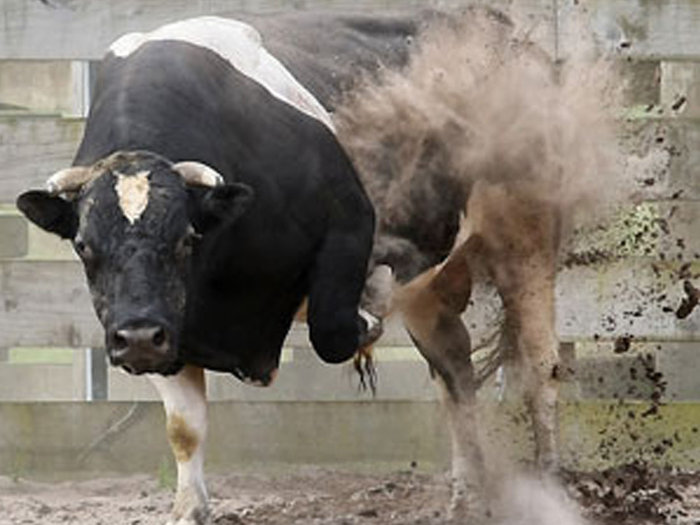As an athletic spectacle, what happened at a downtown theater 106 years ago this month was dull and forgettable – unlike the popular slang expression it spawned that’s still in vogue today and for which Milwaukee has never gotten the credit it deserves.
"Throw the bull" is the expression, and it was a French wrestler’s failure to literally do so here on Oct. 8, 1907 that brought about its coinage.
Wrestling all comers and showing off his brawny physique in a posing routine were the specialties of "Athos the Great" in his tour of U.S. burlesque halls in the early 20th century.
But what set him apart from all the other muscleheads grinding out a living the same way was Athos’s challenge at every stop to wrestle and bring to its knees within one hour the biggest, fiercest bull that could be rounded up.
During his one-week stint at the New Star Theater, Athos posed, grappled with another wrestler on the bill, and invited anyone who paid the 10-to-30 cent admission fee to catch his daily matinee or evening performance at the burlesque house on N. 3rd and W. Wells Streets to come up and try his luck against him on the mat.
But what the theater called its "Feature Extraordinary" was Athos’ match with "an untamed bull – not a "critter" trained to the part, but one just arrived at the Cudahy stockyards from the wilds of the Belle Fourche country (that’s North Dakota, bub), and as tough a proposition as any matador armed to the teeth ever went up against."
Only Athos would use just his two bare hands.
Milwaukee had never seen anything like that before, and when Zachariah Clayton heard what Athos proposed to do he was determined to keep it that way.
To the superintendent of the Wisconsin Humane Society, bullfighting was "a relic of barbarism and the sport of only a depraved and bloodthirsty people," and the night before Athos faced the bull Clayton demanded that New Star manager Frank Trottman call it off, if not for the sake of the poor, dumb animal then for that of the customers whose lives would be endangered should the bull charge into the audience.
Trottman promised the performance would be neither brutal nor bloody, and was he ever right.
When the curtain went up at 11 o’clock the next night a 10-foot high network of ropes stretched across the footlights to dissuade the 1,250-pound Holstein provided by the Bodden Packing Company from making a break for it.
Even if it were so inclined, first the bull would have to snap the cable rooting it to the middle of the stage.
Dressed in a toreador outfit, Athos the Great struggled through five rounds of 10 minutes each (with a two-minute rest in between) to flip the bull over, and at midnight, reported The Milwaukee Journal the next day, the "tired out, lame and somewhat scratched" wrestler gave up.
When the wrestler who had never failed before announced "I can’t throw the bull," the 1,500 spectators in the sold-out theater responded with hoots of derision.
Among them was Con O’Leary, a former prizefighter and now proprietor of a popular tavern next door to the New Star.
"After that," recounted J.J. Delany in The Milwaukee Sentinel of February 5, 1914, "when a customer entered his place who was inclined to boast a little, Con said: ‘Cut it, cut it, you can’t throw the bull.’ The phrase caught on and burlesque artists peddled it about the country."
According to the American Heritage Dictionary of Idioms, Second Edition, "Throw the bull" – meaning "empty talk" or "lies," was "first recorded in 1908." But there’s no mention of Con O’Leary or Milwaukee. Other etymological sources are equally negligent, and it’s time to call BS on them for depriving O’Leary and Milwaukee of long-overdue credit for originating such an enduring and useful phrase.
While we’re at it, give Milwaukee credit for also ending the bull-fighting career of Athos the Great.
Four days after the first debacle, he and the bull were rematched at the New Star. Walter Houlehen, later a famous boxing referee, worked there at the time.
"Again we had the theater stage roped off for the occasion," he recounted in his memoirs 22 years later. "Again Athos entered the ‘arena’ dressed like a toreador."
This time, however, the bull was not shackled at center stage.
"I was perched on an iron ladder anchored to the wall," wrote Houlehen, "and soon Athos was up there with me. He stayed there most of the time, although he went back to the stage at frequent intervals. The bull had the wrestler on the merry run and Athos never tried to get his hands on the animal. That finished Athos and his bull wrestling."







